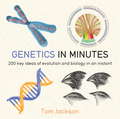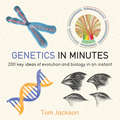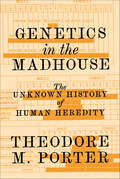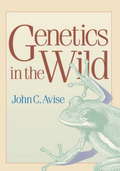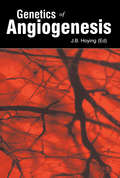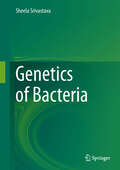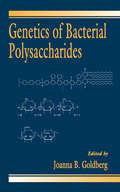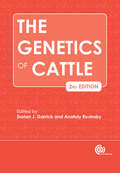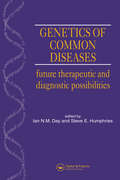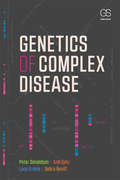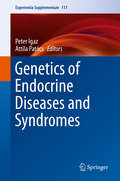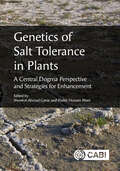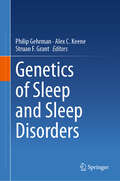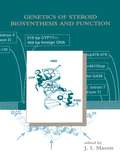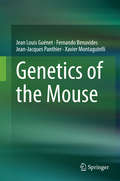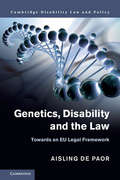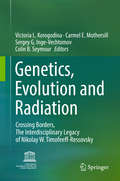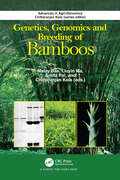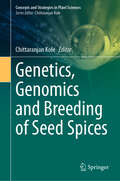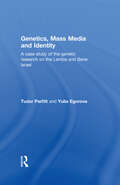- Table View
- List View
Genetics in Minutes (IN MINUTES)
by Tom JacksonGenetics in Minutes is your compact and accessible guide to the central concepts of the science of genetics, revealing how our genes shape our bodies and our lives, and how in turn we are beginning to shape them. Covering the basics of DNA, inheritance and evolution in animals, plants and humans alike - from the origins and development of life to the Human Genome and designer babies - this is the fastest, fullest path to understanding genetics. Contents include Genes, DNA, Natural selection, Darwinism, Stem cell and gene therapies, Evo-devo, Epigenetics, Cloning, Genetic engineering and Artificial life, as well as biology basics such as the Processes of life, Cells, Sex, Classification and Ecology.
Genetics in Minutes (In Minutes)
by Tom JacksonGenetics in Minutes is your compact and accessible guide to the central concepts of the science of genetics, revealing how our genes shape our bodies and our lives, and how in turn we are beginning to shape them. Covering the basics of DNA, inheritance and evolution in animals, plants and humans alike -from the origins and development of life to the Human Genome and designer babies - this is the fastest, fullest path to understanding genetics. Contents include Genes, DNA, Natural selection, Darwinism, Stem cell and gene therapies, Evo-devo, Epigenetics, Cloning, Genetic engineering and Artificial life, as well as biology basics such as the Processes of life, Cells, Sex, Classification and Ecology.
Genetics in the Madhouse: The Unknown History of Human Heredity
by Theodore M. PorterThe untold story of how hereditary data in mental hospitals gave rise to the science of human heredityIn the early 1800s, a century before there was any concept of the gene, physicians in insane asylums began to record causes of madness in their admission books. Almost from the beginning, they pointed to heredity as the most important of these causes. As doctors and state officials steadily lost faith in the capacity of asylum care to stem the terrible increase of insanity, they began emphasizing the need to curb the reproduction of the insane. They became obsessed with identifying weak or tainted families and anticipating the outcomes of their marriages. Genetics in the Madhouse is the untold story of how the collection and sorting of hereditary data in mental hospitals, schools for "feebleminded" children, and prisons gave rise to a new science of human heredity.In this compelling book, Theodore Porter draws on untapped archival evidence from across Europe and North America to bring to light the hidden history behind modern genetics. He looks at the institutional use of pedigree charts, censuses of mental illness, medical-social surveys, and other data techniques--innovative quantitative practices that were worked out in the madhouse long before the manipulation of DNA became possible in the lab. Porter argues that asylum doctors developed many of the ideologies and methods of what would come to be known as eugenics, and deepens our appreciation of the moral issues at stake in data work conducted on the border of subjectivity and science.A bold rethinking of asylum work, Genetics in the Madhouse shows how heredity was a human science as well as a medical and biological one.
Genetics in the Wild
by John C. AviseAward-winning geneticist John C. Avise guides this delightful voyage around the planet in search of answers to nature's mysteries. He demonstrates how scientists directly examine DNA to address long-standing questions about wild animals, plants, and microbes. Through dozens of stories that span the world, nature emerges as a realm where truth can be far stranger than fiction. From a 100-ton mushroom to egg-swapping birds, extinct ground sloths to microbes inside our bodies, Avise examines a cornucopia of natural-history topics and explains how today's modern genetic techniques offer novel insights. Do armadillo litters really contain clones? When is a fig tree not just a single tree? Where have migratory whales traveled? Who are the mothers of the embryos carried by pregnant male seahorses? What insect was the world's earliest farmer? How closely related are Neanderthals to modern humans? Answers to these and many more questions are presented here in a straightforwad manner that reveals Avise's enthusiasm for uncovering nature's hidden ways. Each entry is accompanied by a beautiful illustration from Trudy Nicholson, widely recognized as one of today's leading nature artists.
Genetics of Angiogenesis
by James HoyingAngiogenesis research is one of the most quickly developing areas in biomedicine. It is considered to be a common denominator in society's most important diseases and pharmaceutical companies are racing to develop new angiogenesis-based drugs.This volume focuses on the genetic control of angiogenesis, both in humans and model organisms, and will be a valuable resource to all researchers in the field, including the fundamentals of the process as well as workers in biotechnology.
Genetics of Bacteria
by Sheela SrivastavaDescribed as the earliest, simplest life forms, with unlimited metabolic versatility, bacteria are ideally suited to answer some very fundamental questions on life and its processes. They have been employed in almost all fields of biological studies, including Genetics. The whole edifice of science of Genetics centers around three processes: the generation, expression, and transmission of biological variation, and bacteria offer immediate advantages in studying all the three aspects of heredity. Being haploid and structurally simple, it becomes easy to isolate mutations of various kinds and relate them to a function. The availability of such mutants and their detailed genetic and biochemical analyses lead to a gamut of information on gene expression and its regulation. While studying the transmission of biological variation, it is clear that unlike their eukaryotic counterpart, a more genetic approach needs to be employed. Transmission of genetic information in most eukaryotic organisms rests on sexual reproduction that allows the generation of genetically variable offspring through the process of gene recombination. Even though bacteria show an apparent preference for asexual reproduction, they too have evolved mechanisms to trade their genetic material. In fact, bacteria not only could acquire many genes from close relatives, but also from entirely distant members through the process of horizontal gene transfer. Their success story of long evolutionary existence will stand testimony to these mechanisms. While teaching a course on Microbial Genetics to the post-graduate students at Delhi University, it was realized that a book devoted to bacterial genetics may be very handy to the students, researchers, and teachers alike. A strong foundation in genetics also helps in comprehending more modern concepts of molecular biology and recombinant DNA technology, always a favorite with the students and researchers. Planning the format of the book, emphasis has been laid on the generation and transmission of biological variability. The omission of expression part is indeed intentional because lots of information is available on this aspect in any modern biology book. The contents are spread over seven chapters and the text is supported with figures/tables wherever possible. The endeavor has been to induce the readers to appreciate the strength of bacterial genetics and realize the contribution of these tiny organisms to the growth of biological sciences as a whole and genetics in particular.
Genetics of Bacterial Polysaccharides
by Joanna B. GoldbergBacterial surface or secreted polysaccharides are molecules that can function as barriers to protect bacterial cells against environmental stresses, as well as act as adhesins or recognition molecules. In some cases, these molecules are immunodominant antigens eliciting a vigorous immune response, while in other cases the expression of polysacchari
Genetics of Cattle, The
by Anatoly Ruvinsky Dorian J. GarrickSince the time of domestication more than 10,000 years ago, cattle have played an increasingly crucial role in the development of human civilizations. Progress has been quite remarkable since the turn of the century; the sequencing of the bovine genome in 2009 launched new avenues for furthering our understanding of theoretical and practical aspects of cattle genetics. Covering a vast array of questions, this book reviews major topics from molecular and developmental genetics, disease resistance and immunogenetics to genetic improvement of dairy and beef breeds, addressing all current problems in the field. This second edition includes a new team of authors and completely new chapters on the genetics of fat production, nutrition, feed intake and efficiency, growth and body composition. Fully updated throughout, it provides a valuable resource on cattle genetics for researchers, breeders, veterinarians and postgraduate students.
Genetics of Common Diseases: Future Therapeutic and Diagnostic Possibilities
by Ian N.M. Day and Steve E. HumphriesMany common diseases are partly attributable to the genes which an individual inherits. Early steps have now been made in developing ways to determine which genetic variations are important, with some recent successes. This is a collection of papers from the Fifth Annual Molecular Pathology Symposium on the 10 December 1996. They represent the contributions to that meeting made by a set of distinguished scientists and clinicians whose work pertains to the furtherment of our understanding of the genetic components of common diseases and potential future approaches.
Genetics of Complex Disease
by Peter Donaldson Ann Daly Luca Ermini Debra BevittGenetics of Complex Disease is a concise text for final year undergraduate and first year graduate students. Healthcare professionals and other biomedical scientists trying to come to grips with the impact of new genetics research will also find the book useful. After explaining genetic variation and defining complex diseases, the text shows how and why complex diseases are investigated. The focus then changes to areas where there is strong evidence for the genes/alleles involved. Important ethical consequences are also covered, as are the methods used to generate new genetic data.
Genetics of Endocrine Diseases and Syndromes (Experientia Supplementum #111)
by Peter Igaz Attila PatócsThis book provides a comprehensive overview of the genetic basis underlying endocrine diseases. It covers both the molecular and clinical consequences of these genetic defects, as well as the relevance for clinical care, highlighting issues of genetic counseling. Several endocrine diseases have a genetic background, and contemporary research in the field plays a crucial role in the clinical care of endocrine diseases. In recent years, there have been major developments in our understanding of the genetic basis of endocrine diseases. Several novel genes and mutations predisposing individuals to monogenic endocrine diseases have been discovered, and with the advent of next generation sequencing, a huge amount of new data has become available. Further, novel molecular mechanisms, such as genomic imprinting, have been implicated in the pathogenesis of endocrine diseases.A better understanding of the genetic background of these diseases is relevant not only from the research perspective, but also in terms of clinical care. As such, this book is an essential read for both researchers and clinicians working in the field.
Genetics of Mental Disorders: What Practitioners and Students Need to Know
by Stephen V. Faraone Ming T. Tsuang Debby W. TangIntroduces ideas about inherited genetically based mental disorders and how they combine with environmental factors. thinks about mental disorders with insight.
Genetics of Original Sin: The Impact of Natural Selection on the Future of Humanity
by Christian De Duve Neil PattersonIncreasingly absorbed in recent years by advances in our understanding of the origin of life, evolutionary history, and the advent of humankind, eminent biologist Christian de Duve of late has also pondered deeply the future of life on this planet. He speaks to readers with or without a scientific background, offering new perspectives on the threat posed by humanity's immense biological success and on the resources human beings have for altering their current destructive path. Focusing on the process of natural selection, de Duve explores the inordinate and now dangerous rise of humankind. His explanation for this self-defeating success lies in the process of natural selection, which favors traits that are immediately useful, regardless of later consequences. Thus, the human genome determines such properties as tribal and group cohesion and collaboration and often fierce and irrational competition with and hostility toward other groups' attributes that were once useful but now often ruinously dysfunctional. Christian de Duve suggests that these traits, imprinted into human nature by natural selection, may have been recognized by the writers of Genesis, thus inspiring the myth of original sin. Is there redemption for genetic original sin? In a brilliant and original conclusion, the author argues that, unique in the living world, humankind is endowed with the ability to deliberately oppose natural selection. Human beings have the capacity to devise measures that, while contrary to local or personal interests, can bring forth a safer world.
Genetics of Salt Tolerance in Plants: A Central Dogma Perspective and Strategies for Enhancement
by Kehinde A. Adeboye Victor J. Bamisaye Farwa Basit Usman Rabi’u Bello Javaid Akhter Bhat Jamindar Buddiga Utpal Das Balasundari Dharbaranyam Xianzhong Feng M. Gayathri Abubakar Mohammad Gumi Md Sazzad Hossain Emmanuel O. Idehen Krishnananda P. Ingle Nancy McMulkin Mushtaq Ahmad Najar Oyeboade A. Oyetunde Kapil Patil Britta Pitann Shiva Sai Prasad Fergie Ann Quilloy Md Zillur Rahman J. R. Rajeshwar P. W. Ramteke Hamza Ramzan Vincent Pamugas Reyes Kausalya Sakthivel Palanisamy Senthilmurugan Usama Sheraz Sajid Shokat Pradeep Kumar Shukla Atul Singh Gayatri Venkataraman Mst Ishrat ZahanGene expression in cells follows a prescribed pathway that conforms to the Central Dogma; where the genetic information stored in DNA is transcribed into RNA and then expressed into proteins, which influences most plant traits. Plant salt tolerance research is directed towards identifying nucleotide variants that could contribute to tolerant phenotypes. This book comprehensively presents the current state of knowledge on plant salt tolerance through meticulous analysis of the processes operating across the Central Dogma. It provides a detailed account of modulation of gene expression through genome editing systems to achieve crop improvement against salt stress. It also provides state-of-the-art information on advances in breeding technologies of genome selection and accelerated de novo domestication for rapidly improving the salt tolerance of plants for global food security. This book: 1.Provides a comprehensive coverage of plant salt tolerance mechanisms. 2.Spotlights various factors functioning along the Central Dogma pathway and their regulation in response to salinity. 3.Examines how these factors function to protect the plants from high salinity. 4.Highlights advances in cutting-edge breeding technologies for improving salt tolerance. The book will be of particular value to students and researchers of plant genetics, molecular biology and physiology and those with an interest in salinity and salt tolerance.
Genetics of Sleep and Sleep Disorders
by Philip Gehrman Alex C. Keene Struan F. GrantThis book focuses on the latest research on the genetic basis of the regulation of sleep and wakefulness and of sleep and circadian rhythm disorders, which has been expanding rapidly due to advances in genetics. The book reviews the latest genetic discoveries in animals and humans and explores their implications for getting a good night's sleep. Philp Gehrman, Alex Keene, Struan Grant, and a cadre of top sleep researchers and clinicians explore the genetics of sleep and sleep disorders in depth. The book should appeal to sleep medicine specialists, psychiatrists, geneticists, and neuroscientists.
Genetics of Steroid Biosynthesis and Function (Modern Genetics Ser.)
by J. I. MasonSteroids are among the most widely prescribed drugs for humans, and steroid signaling pathways are present in vertebrates, plants, insects and fungi, presenting new avenues for biotechnological intervention. Genetics of Steroid Biosynthesis and Function focuses on the genetic and cellular aspects of mammalian steroid hormones with particular attent
Genetics of the Mouse
by Jean Louis Guénet Fernando Benavides Jean-Jacques Panthier Xavier MontagutelliThis book, written by experienced geneticists, covers topics ranging from the natural history of the mouse species, its handling and reproduction in the laboratory, and its classical genetics and cytogenetics, to modern issues including the analysis of the transcriptome, the parental imprinting and X-chromosome inactivation. The strategies for creating all sorts of mutations, either by genetic engineering or by using mutagens, are also reviewed and discussed in detail. Finally, a last chapter outlines the methodology used for the analysis of complex or quantitative traits. The authors also discuss the importance of accurate phenotyping, which is now performed in the mouse clinics established worldwide and identify the limits of the mouse model, which under certain circumstances can fail to present the phenotype expected from the cognate condition in the human model. For each chapter an up-to-date list of pertinent references is provided. In short, this book offers an essential resource for all scientists who use or plan to use mice in their research.
Genetics, Disability and the Law: Towards an EU Legal Framework (Cambridge Disability Law and Policy Series)
by Aisling De PaorWhile advances in science and technology bring many advantages, we must not ignore the harm that they can cause. Rapid changes in genetic testing are a prime example, and indicators can now help to detect, address and treat diseases. However, in this new study, Aisling de Paor examines how genetic testing is also being used for non-medical reasons, for example for work opportunities and insurance coverage. Genetics, Disability and the Law is the first book of its kind to substantively consider an EU-level response to the use of genetic information. de Paor discusses how to help genetic and scientific research to evolve and grow, how to enhance public confidence in research, and how to control it so that it recognises our values and fundamental human rights. An understudied but vitally important topic, de Paor's work provides a valuable and timely contribution to the field of disability rights. Presents a practical consideration of an EU-level legislative response to controlling the use and misuse of genetic information, appealing to those involved in the regulation of this field Takes a human rights and disability approach to considering the regulation of genetic information, which will interest scholars and policymakers from a variety of disciplines, in particular because it considers the intersection of disability and genetics Considers normative and non-normative attitudes to the regulation of genetic information, giving readers a new and varied insight
Genetics, Evolution and Radiation
by Victoria L. Korogodina Carmel E Mothersill Colin B. Seymour Sergey G. Inge-VechtomovThis book is dedicated to the great scientist and outstanding individual Nikolay Wladimirovich Timofeeff-Ressovsky. The book brings together a number of brief stories/essays about Timofeeff-Ressovsky including "Stories told by himself", and scientific chapters addressing his major research areas: genetics, radiobiology, radiation ecology and epidemiology, and evolution. Timofeeff-Ressovsky contributed to several fields of biology and established new directions of scientific research. He often repeated the phrase, which would later become famous: "Science should not be approached with the ferocity of wild animals". In keeping with that philosophy, the issues discussed here are still open. Each scientific part starts with a current review; the chapters present leading scientific schools and views. The main theme discussed in the genetics part is mutation variability in the context of linear (replication, transcription, translation) and conformational template processes, and its dependence on phylogenetic group. In turn, the radiobiology chapters focus on the reorganization of DNA, cell, and population variability under low-dose irradiation, sparking indirect processes and adaptive response. The radiation ecology and epidemiology parts present data on the consequences of nuclear plants and related accidents for ecological systems and human beings. Here some approaches to estimating radiation risks are also offered. Evolution laws are demonstrated in the genomic universe, plant-microbe symbiosis, stabilizing and destabilizing (directional) selection. The last essay demonstrates the principles of organization operating in local animal populations, which are approached as social organisms of complex systemic nature. The chapter 'Radiation-Induced Aging and Genetic Instability of Mesenchymal Stem Cells: An Issue for Late Health Effects?' is available open access under a CC BY 4. 0 license. >
Genetics, Genomics and Breeding of Bamboos (Advances in Agri-Genomics)
by Chittaranjan Kole Malay Das Liuyin Ma Amita PalThis book entitled "Genetics, Genomics and Breeding of Bamboos" provides a comprehensive overview on the economically and ecologically important non-timber plant group bamboo. The book focuses on the most recent advances in bamboo research in diverse fields including botany, genetic resources, traditional and molecular breeding, disease and pest resistance, tissue culture and genetic transformation and genomics perspective. The different chapters are authored by internationally reputed experts on this plant and is a good source of information for students, scientists, farmers, and bamboo resource management advisers on this plant, which is gaining increase importance on international commerce.
Genetics, Genomics and Breeding of Seed Spices (Concepts and Strategies in Plant Sciences)
by Chittaranjan KoleThis volume presents detailed reviews on biochemistry, classical genetics and traditional breeding, germplasm diversity, molecular genetics, tissue culture, biotechnology, and structural and functional genomics of ten major seed spices including ajwain, anise, celery, coriander, cumin, dill, fennel, fenugreek, Nigella and parsely. The seed spices include the most ancient crops of the world being cultivated for thousands of years as spices, condiments and herbal medicines. Besides adding attractive flavor and taste, seed spices are used as preservatives, and preventive and curative phytomedicines. Despite the immense importance of these crops and their multipurpose utilities, there is no comprehensive compilation of the information on genetics, genomics and breeding in these crops. The present book fills up that gap in literature. This book is useful to the students, teachers and scientists in the academia and relevant scientists interested in genetics, genomics, breeding and genetic engineering and also crop production, pathology, physiology, of seed spices. This book is also useful to the seed companies and industries engaged in long-term preservation, essential oil-based products and pharmaceuticals.
Genetics, Mass Media and Identity: A Case Study of the Genetic Research on the Lemba
by Tudor Parfitt Yulia EgorovaThis is the first book to explore the effect of genetic research on the Lemba Judaising community of Southern Africa and the phenomenon of Israelite identity. The science of genetics as relayed by the media is perceived by laymen as being irreproachably objective 'hard science': its disinterested 'scientific' findings appear immensely impressive and may therefore act as a powerful catalyst for change. In this case, an oral tradition cherished by many of the Lemba that they are of Jewish origin appears to be supported by recent DNA testing, which has deeply affected the narrative and religious identity of the group and the way the tribe is perceived in the Western world. International in appeal, this topical text brings together cutting-edge research on the social, cultural and ethical implications of genetics and the study of Judaising movements across the world. This book will be of interest to researchers and students of Jewish history, genetic anthropology, race and ethnicity studies, and religious and cultural studies.
Genetics, Physiology and Cultivation of Moth Bean, Cowpea and Horse Gram
by Rakesh PathakThis authored book gives insight into the morphology, physiology, genetics, plant protection and biotechnology of three important arid legumes, viz., moth bean, cowpea and horse gram. There are seven chapters for each crop that provide in-depth information on cultivation, genetic improvement, plant protection measures, management of physiological and abiotic stresses along with related genetic markers and biotechnological advances pertaining to these legumes. The chapters present research findings and brief reviews concerning the advances made in the improvement of these legumes.Legumes are utilized as pulses or grains aiding as an important source of protein for both human and animal consumption and also provide raw materials to the food and feed industries. They are also valuable for soil building, improving soil quality and biological nitrogen fixation. Physiology and genetics provide an inimitable source of information on the distinct aspects of basic and applied legume research for general readers, students, academicians and researchers. Arid legumes are crops characterized by inherent features and capabilities to withstand adverse and harsh climatic conditions, significantly replenish the soil, as well as provide protein and micronutrients. Adaptability to several stresses including drought makes them key to agriculture in areas receiving scanty rainfall. This comprehensive book disseminates significant information on the genetic diversity, cultivation, manipulation through mutagenic techniques, molecular biology and other breeding techniques. The book, therefore, is of importance to teachers, researchers and policymakers who are interested to acquire knowledge about moth bean, cowpea and horse gram. It also serves as an additional reading material for MSc and PhD students of agriculture and environmental sciences. The book is also useful to national and international agricultural scientists and policymakers.
Genetics: A Beginner's Guide (Beginner's Guides)
by David Suzuki Burton Guttman Anthony Griffiths Tara CullisThis is a new introduction for readers who wish to know more about the science that is changing our world.
Genetics: A Conceptual Approach
by Benjamin A. PierceWith Genetics: A Conceptual Approach, Ben Pierce brings a master teacher’s experiences to the introductory genetics textbook, clarifying this complex subject by focusing on the big picture of genetics concepts and how those concepts connect to one another. The new edition continues the Pierce tradition of pedagogical excellence and scientific currency. In addition, it features a new digital component, SaplingPlus, combining Sapling’s acclaimed online homework with an extensive suite of interactive learning resources and course management features.
